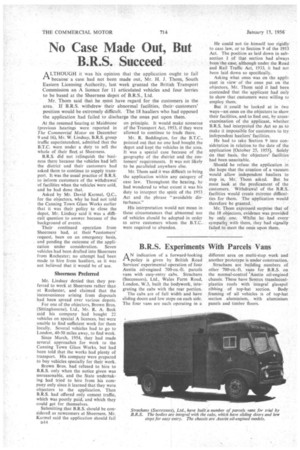No Case Made Out, But B.R.S. Succeed
Page 60

If you've noticed an error in this article please click here to report it so we can fix it.
LTHOUGH it was his opinion that the application ought to fail " because a case had not been made out, Mr. H. J. Thom, South Eastern Licensing Authority, last week granted the British Transport Commission an A licence for 11 articulated vehicles and four lorries to be based at the Sheerness depot of B.R.S., Ltd.
Mr. Thom said that he must have regard for the customers in the area. If B.R.S. withdrew their abnormal facilities, their customers' position would be extremely difficult. The 18 hauliers who had opposed the application had failed to discharge the onus put upon them.
At the resumed hearing at Maidstone (previous hearings were reported in The Commercial Motor on December 9 and 16), Mr. W. Lindsay, B.R.S. group traffic superintendent, admitted that the B.T.C. were under a duty to sell the whole of their fleet at Sheerness.
B.R.S. did not relinquish the business there because the vehicles had left the district and their customers had asked them to continue to supply transport. It was the usual practice of B.R.S. to inform customers of the withdrawal' of facilities when the vehicles were sold, and he had done that.
Asked by Mr. David Karmel, Q.C., for the objectors, why he had not told the Canning Town Glass Works earlier that it was their policy to close the depot, Mr. Lindsay said it was a difficult question to answer because of the background of events.
Their continued operation from Sheerness had, at their °customers' request, been on an emergency basis, and pending the outcome of the application under consideration. Seven vehicles had been drafted into Sheerness from Rochester; no attempt had been made to hire from hauliers, as it was not believed that it would be of use.
Sheerness Preferred
Mr. Lindsay denied that they preferred to work at Sheerness rather than at Rochester, and claimed that the inconvenience arising from disposals had been spread over various depots.
For one of the objectors, Brown Bros. (Sittingbourne), Ltd., Mr. R. A. Beck said his company had bought 22 vehicles on special A licences, but were unable to find sufficient work for them locally. Several vehicles had to go to London, 40-50 miles away, to find work.
Since March, 1954, they had made several approaches for work to the Canning Town Glass Works, but had been told that the works had plenty of transport. His company were prepared to buy vehicles specially for their work.
Brown Bros. had refused to hire to B.R.S. only when the notice given was unreasonable, and the State undertaking had tried to hire from his company only since it learned that they were objectors to the application. Then B.R.S. had offered only cement traffic, which was poorly paid, and which they could get for themselves.
Submitting that B.R.S. should be considered as newcomers at Sheerness, Mr. Karmel said the application should fail D14 on principle. It would make nonsense of the Transport Act, 1953, if they were allowed to continue to trade there, Mr. R. Beddington, for the B.T.C., pointed out that no one had bought the depot and kept the vehicles in the area. It was a special case because of the geography of the district and the customers' requirements. It was ncit likely to be paralleled anywhere else.
Mr. Thom said it was difficult to bring the application within any category of case law. Throughout the hearing, he had wondered to what extent it was his duty to interpret the spirit of the 1953 Act and the phrase "avoidable disturbance."
His interpretation would not mean in these circumstances that abnormal use of vehicles should be adopted in order to serve customers whom the B.T.C. were required to abandon.
He could not tie himself too rigidly to case law, or to Section 9 of the 1953 Act. The position as laid down in subsection 1 of that section had always been the case, although under the Road and Rail Traffic Act, 1933, it had not been laid down so specifically.
Asking what onus was on the appli, cant in view of the onus put on the objectors, Mr. Thom said it had been contended that the applicant had only to show that customers were willing to employ them.
But it could be looked at in two ways—an onus on the objectors to show their facilities, and to find out, by crossexamination of the applicant, whether. B.R.S. had interpreted the Act so as to make it impossible for customers to try independent hauliers' facilities.
He had to take Section 9 into consideration in relation to the date of the application [October 25, 19551. Solely On that basis, the objectors' facilities had been unsuitable.
Should he refuse the application in the hope that the creation of a vacuum would allow independent hauliers to step in, Mr. Thom asked. 13ut he must look at the predicament of the customers. Withdrawal of the B.R.S. facilities would create extreme difficulties for them. The application would therefore be granted.
Mr. Thom expressed surprise that of the 18 objectors, evidence was provided by only one. Whilst he had every sympathy with them, they had signally failed to meet the onus upon them.




























































































































